-
Posts
1,268 -
Joined
-
Last visited
Content Type
Profiles
Forums
Events
Store
Posts posted by Andrej Stancak
-
-
2 hours ago, Mathias Baumann said:
Andrej,
You could be right about that. Maybe PULSE could be used to identify Prayer Man by trial-and-error, that means by feeding it different images of different people and see which output looks most realistic. I don't know.
But I see a technical problem here:
So it appears you need some special hardware. CUDA was developed by Nvidia. I have a AMD RADEON HD 6450 installed in my computer. I don't think it'll support CUDA, but I'll give it a try anyway.
I see the problem. They seem to run the program using the graphic card processor. My laptop also has an AMD RADEON card and, threrefore, I cannot help at the moment. I may have access to a proper computer hosting an Nvidia card at some point in the future. The article also mentions alternatives to AI, maybe those could be easier to implement.
-
While it seems that there is no dispute on this Forum about the impossibility of the alleged female to represent the full figure of Prayer Man, it may still be useful to point out that Prayer Man having the head aligned with the head of the alleged female would not match Prayer Man's figure in Darnell. The person reaching only to the "head" of the trimmed image would be either much shorter than Prayer Man in Darnell or stand on the third top step (Prayer Man in Darnell effectively stood on the second top step albeit with only his left foot).
Here is an approximate alignment of Wigeman's and Darnell's doorway with guiding lines. If the top of Prayer Man's figure in Wiegman would only reach to the top of the alleged female (the trimmed image), the distance from the horizontal bar in the aluminium door frame would be much larger than in Darnell. In contrast, the top of the head for the full figure in Wiegman aligns with the top of Prayer Man's head in Darnell pretty well given slightly different azimuth and elevation angles in both pictures. The purple line connects the right hand in both Prayer Man figures.
Using the figure of Buell Wesley Frazier as a measuring stick, the top of Prayer Man' head reaches to the lower aspect of Frazier's chin in Darnell and if the full figure of Prayer Man is used in Wiegman. In contrast, the top of the head of the alleged lady would only reach to the level of lower ribs on Frazier's chest.
I hope this ends the odd story of alleged female face in the Wiegman still.

-
Just now, Mathias Baumann said:
Andrej,
I think what Dr Rudin was trying to say is this: the output of her software is determined by the input. So if you feed it a picture of Oswald you'll get Oswald as an output. If you feed it Sarah Stanton you'll get Sarah Stanton. You can't use it to enhance the quality of the image. It's only useful if you already know who's in the picture and if you have high-quality photos of that person that you can feed into the software.
Mathias:
their work would make no sense if you only receive the same image which was used to scramble it and then reconstruct. However, I understand that authors want to be on a safe side and do not want someone falsely identifying a person in blurred images and possibly arrive at wrong conclusions. Anyway, I leave it with you whether you want to follow this line, and would understand fully if you decide not to.
-
14 minutes ago, Mathias Baumann said:
Can you point me to a source where I can download the entire film in high resolution?
Mathias:
there is no Darnell film of high resolution available to the research community, unfortunately. I work with a set of images which I believe were exported by Robin Unger several years ago. I can upload the folder onto Dropbox if you wish.
The image I believe contains facial features that could possibly be enhanced using AI is this:
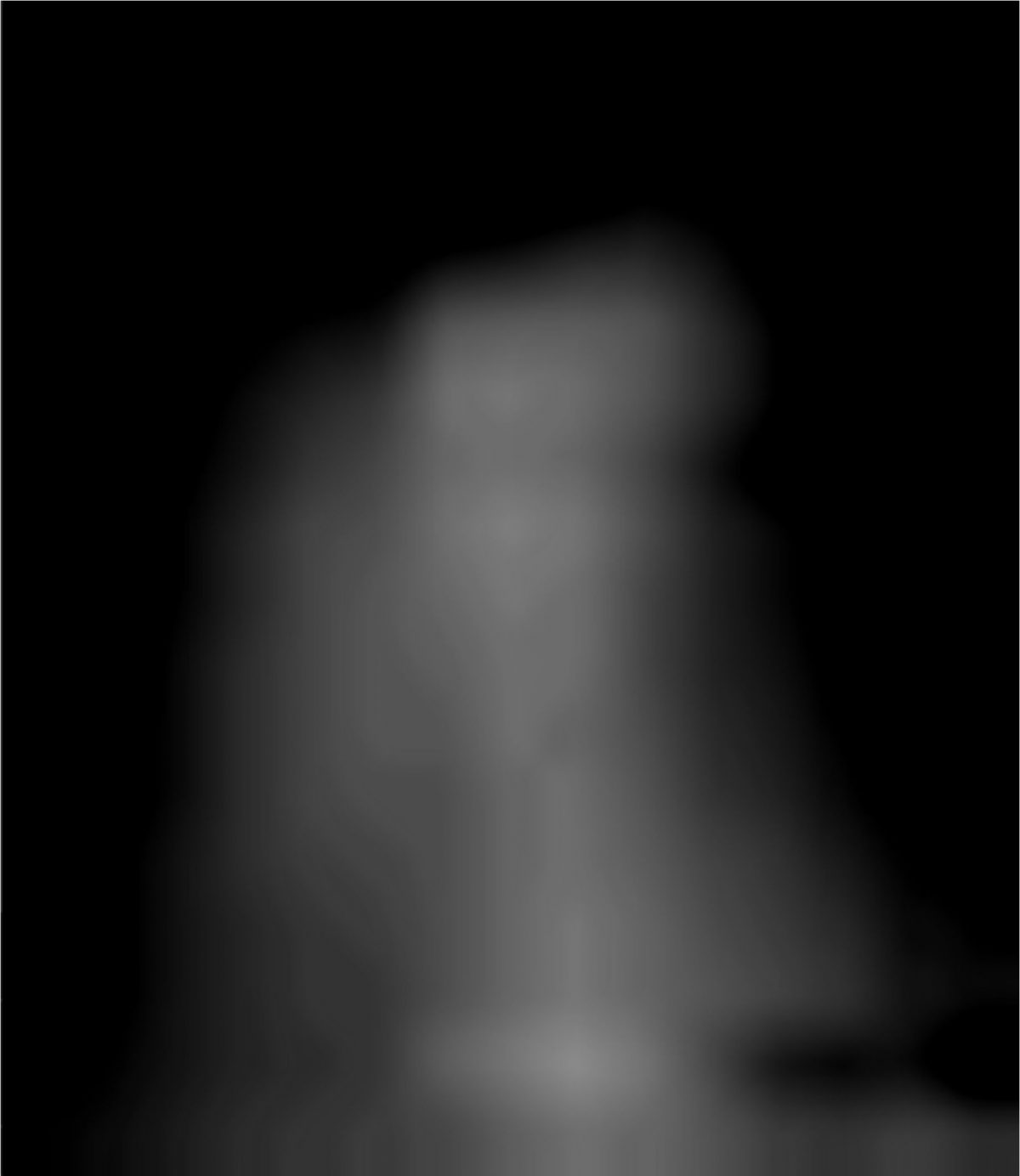
Here is the same image (the left-most one) with progressively more intense overlays of Lee Oswald's head. Amazingly, the orientations of Prayer Man and Lee Oswald's head in both images are practically identical.
In the original image, the small bright spot below the chin is most likely Adam's apple. Lee had an elevated nasolabial region, rising toward the upper lip. I guess this can be seen in the original picture. If there is any picture offering a chance of revealing Prayer Man's facial features, it would be this one.

-
Mathias:
please let me know if I can be of any assistance. Once you upload their libraries into Python and run the code with their sample image, I would prepare a suitable image of Prayer Man's face. The Darnell still we all use in our posts, although giving some interesting details, has the nose and eyes areas burned out, and no AI could reconstruct anything unless there is at least some signal in the image.
-
I would like to comment on the alleged female seen in the Wiegman still and hope not to add to the confusion. The alleged image of a female in Wiegman was brought here by one former member of the Forum back in 2016. The thread is named "Prayer Person - Man or Woman? and the thread has been moved outside the Debate folder to JFK Research folder where it can still be visited.
After quite a number of repeated requests, the image of alleged female was posted and it was the small image in the right-most panel of the composite picture below. After further requests to show the original, unprocessed image from which this trimmed image was produced, Chris Davidson kindly posted the Wiegman still on which he did his enhancements. This original image is the left-most panel in the composite below. I would like to ask everyone to inspect this original image and decide if it is possible to see more than a very faint contour of a person standing at Prayer Man spot and whether there can be any confidence in saying that that person was a male or female.
The enhancements which Chris made on the original still, as I understand it, were only in form of adding some brightness and contrast. I have replicated these steps and found the same figure as Chris did (middle panel in the composite below). I see distorted information in the head and neck region due to low signal in the original image (left). The enhancement algorithms, unfortunately, do not differentiate between real information and noise and make both type of information prominent. Please see the misalignment of the upper and lower part of the head which is typical in noisy images having also low resolution.
There was someone else who cut the part of Prayer Man's head from Chris'es enhancement, namely the lower face, neck and upper chest, and made it a new picture and claimed it was a female. The image was "enhanced" further, rotated by 2 degrees and trimmed. However, the composite image clearly shows that that image 1) originates from an area of Wiegman still which contains very little signal and any enhancements, therefore, lead to spurious results, 2) it was trimmed not to show the upper part of Prayer Man's head. The image of alleged lady which some claim to be Sarah Stanton is a photographic misinterpretation resulting from the lack of understanding of the original picture or even an intentional misleading of research community.

This next picture shows, side-by-side, the figure of Prayer Man in Darnell and in the enhanced Chris Davidson's still from Wiegman film. Please note that the true contour of Prayer Man figure in Wiegman also includes the top part of the head above the line of trimmed image of alleged female face.

-
2 hours ago, Mathias Baumann said:
So I just had an e-mail exchange with Dr Rudin. As I suspected her software is not suitable for identifying Prayer Man. In fact, she wrote that
I guess that means we'll never know who Prayer Man is. There's just not enough information in the picture.
I guess it only means that Dr Rudin's method is not suitable for disclosing with certainty the true appearance of someone's face if the image is blurred. It would still be interesting to see what face would come out from their AI analysis if the face of Prayer Man would be used as input.
-
Mathias:
I wish you good luck with the AI analysis and hope you will update us about any progress.
-
10 hours ago, Mathias Baumann said:
I wonder if artificial intelligence could be used to improve the quality of Prayer Man's image. Software that could be capable of this has recently been developed.
So, Mathias, will you contact Cynthia Rudin regarding enhancing Prayer Man in Darnell? Will you implement their free Python code and run Prayer Man image as input? I can help you with identifying the still possibly having the best chance to reveal facial features if you decide to pursue this interesting line of research.
-
Mathias:
I now know that one person who will not be convinced about the possibility that Prayer Man was Lee Oswald is you. It is also clear to me that you will spent zero effort in pursuing Prayer Man topic with your own research. Why then did you reopen this thread after 8 months since the last post?
-
On 8/20/2020 at 1:41 PM, Mathias Baumann said:
I have a question for those who believe that "Prayer Man" was Lee H. Oswald.
In your opinion, what role did Oswald play in the assassination?
I believe that Oswald did play some part in the assassination. Otherwise it would've been very difficult for the conspirators to make him the "patsy". And because of his Russian and Marxist background Oswald was the perfect scapegoat. I think the conspirators knew that his association to "Comrade Kostin" would make sure that the authorities would not touch any evidence for the involvement of other shooters. So Oswald had to be the fall guy.
But for that the conspirators needed to have some control over him. And they surely could not allow him wandering around outside the building. If one of them (Dark Complected Man? Umbrella Man?) had spotted him they would certainly have aborted the assassination. So they had to make sure they knew where he was. And what better way than putting him in the 6th floor window with a rifle?
I also think that we cannot discard the possibility that Prayer Man is not one of the TSBD staff at all but just a random bystander. Everyone was anxiously waiting for the motorcade to arrive, so I think it's not unlikely that they (the staff) would not have noticed a stranger looking for a good spot to take some photos (I think it has been argued that "Prayer Man" might be holding a camera in his hands).
Mathias:
all the questions of yours are valid. I have been contemplating those questions while working on different aspects of Prayer Man problem.
1. As far as Oswald's active role in the assassination is concerned, his role may have ranged from not knowing anything about the plot itself, to being part of a mock assassination attempt, to eventually being an essential and willing part of the assassination plot while realising too late that all the plausible denials that he was assured of have collapsed one by one on Friday afternoon.
The most "innocent" scenario, as many have suggested already, could be that Lee Oswald was asked to bring his rifle to the Depository on Friday morning to trade it. Lee had his lunch in the first-floor lunchroom and heard a wave of noise as the motorcade approached Houston street and decided to find out what was this excitement about. His decision to go out would accords Captain Fritz's notes and the handwritten notes of the FBI agent James Hosty uncovered recently by Bart Kamp. Lee would arrive to the doorway after President's limo passed the Depository (which explains the absence of Prayer Man in Hughes film) and within seconds of the last shot (which explains his presence in the doorway in the Wiegman film). The rifle trade scenario is supported by Gerry Patrick Hemming's statements who bragged about offering to Lee a price double of the purchase price.
The mock-assassination scenario has been elaborated quite well by Walt Brown. The presence of Lee in the doorway could have been a calculated plausible denial which would later serve to exonerate Lee Oswald after initially linking him with the assassination through his rifle.
The most conspiratorial scenario would see Lee actively conspiring with Jack Ruby, anti-Castro Cubans and rogue CIA agents to kill President Kennedy only to find that the plan went different to what he was told.
Whichever scenario was true, two aspects are the common denominators to all scenarios. First, Lee Oswald brought his rifle to the building, and second, he realised being a patsy right away, within seconds of the shooting. If Lee would not bring his rifle to the building and would he stand in the doorway, there was no way of pinning any crime on him, at least not that quickly to make him flee the building. The moment of his realisation, in my view, is depicted in Darnell stills. One can see that all doorway occupants naturally adjust their locations and gazes to optimise their views of the Triple underpass area. Not so Prayer Man. He stares in direction of the Records building or similar. This is very odd and suggests he was frozen and spent time pondering what to do next. Interestingly, another person who also fails to optimise his view of Grassy Knoll/Triple underpass was Buell Wesley Frazier.
2. The level of control over Lee Oswald's movements is a relevant aspect of the case. I would again refer to the three possible scenarios outlined above as the level of control depends on what was Lee Oswald's role. It is possible that, e.g., in the mock-assassination scenario, he was even asked to go out and let be seen by other employees as this would be used to exonerate him after all other leads would initially point to him.
3. It is also necessary to consider that Prayer Man was a random person from the crowd of people standing in Dealey Plaza area. I found only one hint that somebody may have walked into the doorway when the motorcade was passing through Houston and Elm street. Ronald Fischer made a peculiar remark in his November 22 affidavit:
"I do remember one peculair [sic] thing happened just at the time I saw the man up there. There was a girl walked in the Texas School Book Depository Building, a rather tall girl, and she looked to me like she might be an employee in that building. She was walking in while everyone else had been coming out."
https://mcadams.posc.mu.edu/russ/testimony/fischer1.htm
However, Prayer Man was definitely not a female and therefore, Fischer's remark does not account for Prayer Man's figure.
In order for someone from the crowd to walk up the steps and be photographed as Prayer Man, the person would have to possess all the features which Prayer Man shares with Lee Oswald. The likelihood of a random person from a sample of about 500-550 people showing the same features which Prayer Man shares with Lee Oswald would be extremely small. It would have to be a male, a Caucasian, a man sized 5' 9 1/2'', have a hairline of male baldness Type II, have dark hair, someone who used to stand with his left foot in the front and the leg flexed in knee joint (and whose own brother used to stand this way too), he would have to wear worker type of clothes with shirt sleeves rolled up to the elbows and the top one or two buttons open (as Lee Oswald used to do), with shirt likely being of maroon colour (this color converts into the grey seen on Prayer Man in Darnell), would wear grey pants (not black), with greys of the shirt and pants being identical to the shirt CE150 and pants CE157, and have the shirt pulled out of trousers. The likelihood of all these features occurring simultaneously by chance is very, very small.
There is one more aspect which promises to lower the random chance of someone from the crowd stepping in as Prayer Man - it is the distribution of dark specks on CE150, the maroon (light red) shirt which Lee Oswald wore on Friday morning. If the distribution of the dark specks fits with the dark area seen on Prayer Man's shirt in Darnell, the proof of identity would be indisputable. It is this aspect of Prayer Man's figure I am focusing at in my Tom Wilson project.
-
Thanks, Chris, this is very helpful. I hope to be able to to reproduce the exact body and head orientations in Z315 and Mary Moorman picture to check your estimate with a different approach.
However, I also see a good point in Joe's comment too - did the mass of the tissue really go off from the President's head in Mary Moorman picture? Could there be a double shot with Mary Moorman only capturing the first, maybe the less devastating head shot?
-
Chris:
I hope you will not find this message as too far from the main thread, however, I would like to know your opinion on the exact timing of Mary Moorman picture relative to Zapruder film. Did you have a chance to look into this? My estimate just from eyeballing the similarities of JFK's body posture in Moorman picture and Zapruder film is that Moorman picture could be equivalent to Z314 or Z315. Any thoughts would be very much appreciated.
-
On 6/20/2020 at 12:35 AM, John Butler said:
“Later on, he invited me to go to a party on Davis Street. Candy Barr’s party.
This part of Mrs. Hollies's recollection can hardly be true. Candy Barr was released from jail on April 1, 1963 and was not allowed to live, not to mention giving any striptease performances, in Dallas. She lived in Edna, Texas (about 5 hour drive from Dallas) during the time of President's assassination. How could Lee Oswald attend her party on Davis Street, Dallas in Autumn of 1963?
-
John:
thanks for posting the excerpts from Mary Hollies's Oral History interview. Her statements contain some mind-boggling data, of course, if her recollections are truthful.
Below is her statement for the FBI. It is one of many statements the FBI took from the Depository employees, and all these statements are in CE 1381. The remarkable thing is that all the statements follow the same template and are as non-informative as possible. The FBI did not want to hear about any employees' encounters with Lee Oswald at all.
Regarding the thread itself, I believe that Lee Oswald rode a bus to work regularly but nobody, no even the first generation researchers, chose to ask the bus drivers about Lee Oswald. It is a shame, however, Oswald was likewise not asked about how he got from his room at North Beckley to the Texas Theater. Postal Inspector Holmes was asked by the Warren Commission about whether the interrogators have probed Lee Oswald on his exact route from North Beckley to the Texas Theater, and Holmes conferred he had assumed that this point was already clarified in previous interrogation sessions... There was no genuine interest in learning about Lee Oswald's way of life, his contacts and how he spent time. The most efficient way how not to learn anything of significance from a suspect is to allow him to be killed.

-
16 hours ago, Steven Kossor said:
In a very short span of space & time (unless the limousine stopped, in which case the time interval would necessarily be lengthened), it appears that so much head movement must have happened (a turn to the right before receiving the wound that caused the blowout at the back of the head to exhaust material onto the driver's side tail light and officer Hargis, then a turn to the left to be captured by Mary Moorman's photo). Is anyone disagreeing that the physical evidence I'm citing necessarily requires the head movements I'm describing?
Steven:
your point regarding exact head orientation is a crucial one, and it is interesting how it aligns with Chris's comment. While Chris works on the reconstruction of the exact movements and locations of President's limo, the exact spatial location of President's head is equally important for any trajectory analysis.
I took advantage from a photograph having a similar view angle of JFK's head and shoulders in one of the motorcade photographs, however, this is only a rough approximation of the exact orientation of President's head in MM picture.
Sorry to boil my soup one more time, however, it appears necessary to build an accurate 3D model of President's body, especially of his head, and arrange the model head in the space to match President's figure in Mary Moorman picture and in several critical frames of Z film. This would also allow to understand the correspondence between Z-film and MM and it would also be an independent verification of the timeline provided by Chris and Mark.
-
16 hours ago, Chris Davidson said:
Andrej,
I think I have to correct that back to 2.379ft past the extant z313 location.
The 4.5ft mark was only part of the adjustment process which I will soon explain.
Irregardless, Tom was right about the syncing problems that he mentions in the interview.
This is an amazing progress, anyway. Knowing the precise timing and the exact location of the fatal shot is a prerequisite for any trajectory analysis. Sorry for not contributing to your thread, I am just busy with the image analysis method project.
-
10 hours ago, Chris Davidson said:
Tom was close at 4ft farther down Elm.
Documentation proves out to 4.5ft
https://drive.google.com/file/d/1T_L-ofjszZmZnMK9raiElwQfYA9YjZqx/view?usp=sharing
Thanks for this update of the exact location of President's limo at the time of the fatal head shot. It is reassuring that two experts have independently arrived at a very similar estimate.🏆
-
It would be a big loss for the Forum if Bart had left. I hope we will be able to see Bart's contributions on this Forum soon again. Personal animosities do exist among people, however, they are just Māyā and as such they should not disrupt our routes.
-
Thanks, Ray, for reading my posts and your comment.
Here is a mold of the head wound prepared by Tom Wilson. According to Don Phillips's book "A deeper, darker truth", Tom worked on this 3D representation of Kennedy's head wound, that he was able to see in Mary Moorman picture, for three months. Tom allegedly scanned the picture in a similar way as a CT or an MR would scan the brain. I would love to know what parameters of lighting and recording was Tom changing, obviously in some systematic manner.
The top panel shows the head wound (Tom's mold) whereby the missing space represents the lost tissue. This is a view posterior transversal view (as if you would have your eyes about behind the back of President's head and would look toward the wound. The right is on the right. The bottom panel is a 3D representation of the same wound (obtained from the same copy of Mary Moorman's picture) reconstructed from my experiments.
Both reconstructions have a lot of common. There are two tunnels possibly due to two bullets or two fragments of one bullet, however, there is only so much detail one can extract from this image and it is also possible that one bullet caused one big wound with this geometry. The right tunnel is taller than the left tunnel but the left tunnel appears to be broader than the right tunnel. Both tunnels expand towards the rear. The two tunnels are separated by tissues which create a wall and that wall is orientated in about 15-20 degree angle toward the right.
If the two holes and the tunnels would be due to to particles (bullets or bullet fragments), the right particle would likely continue straight backward and the left particle would go leftward toward the two motorcycle officers riding at the left fender of President's limo.
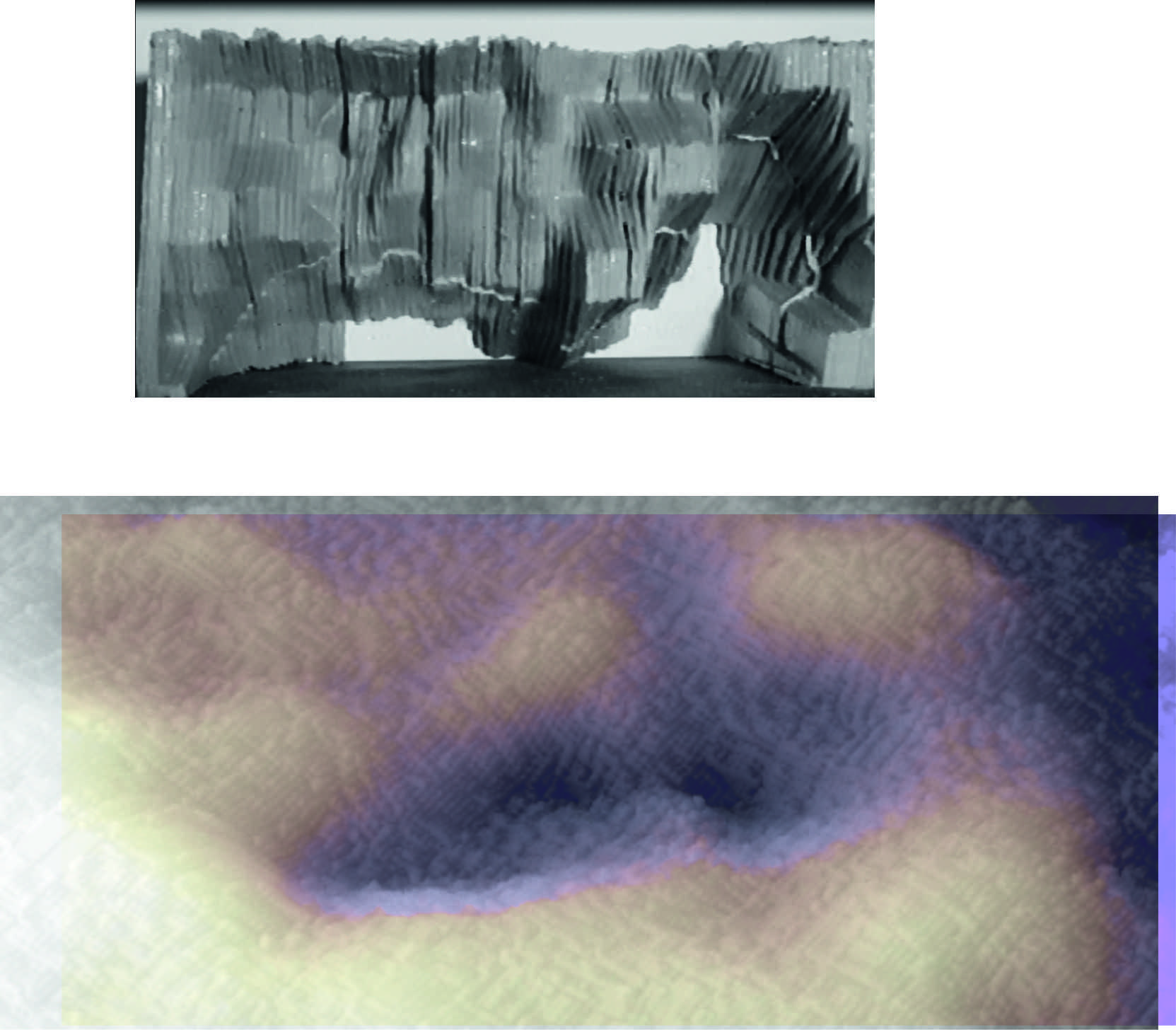
-
To continue the exploration of President's head wound in Mary Moorman's picture and of course, to see if it would be possible to reproduce Tom Wilson's data, I made own photographic experiments by shooting Mary Moorman's picture under different light conditions (xenon flashes at 5 Hz with background light, produced by halogen lamps, varying in 5-s cycles) and recording video using a machine vision near-infrared camera. The camera has an expanded spectral range for wavelengths above visible light (>780 nm) up to about 1150 nm. I also use different optical band-pass filters.
This is the setup which I currently use. The camera is the small gadget on the massive tripod in the right-hand side part of this picture.
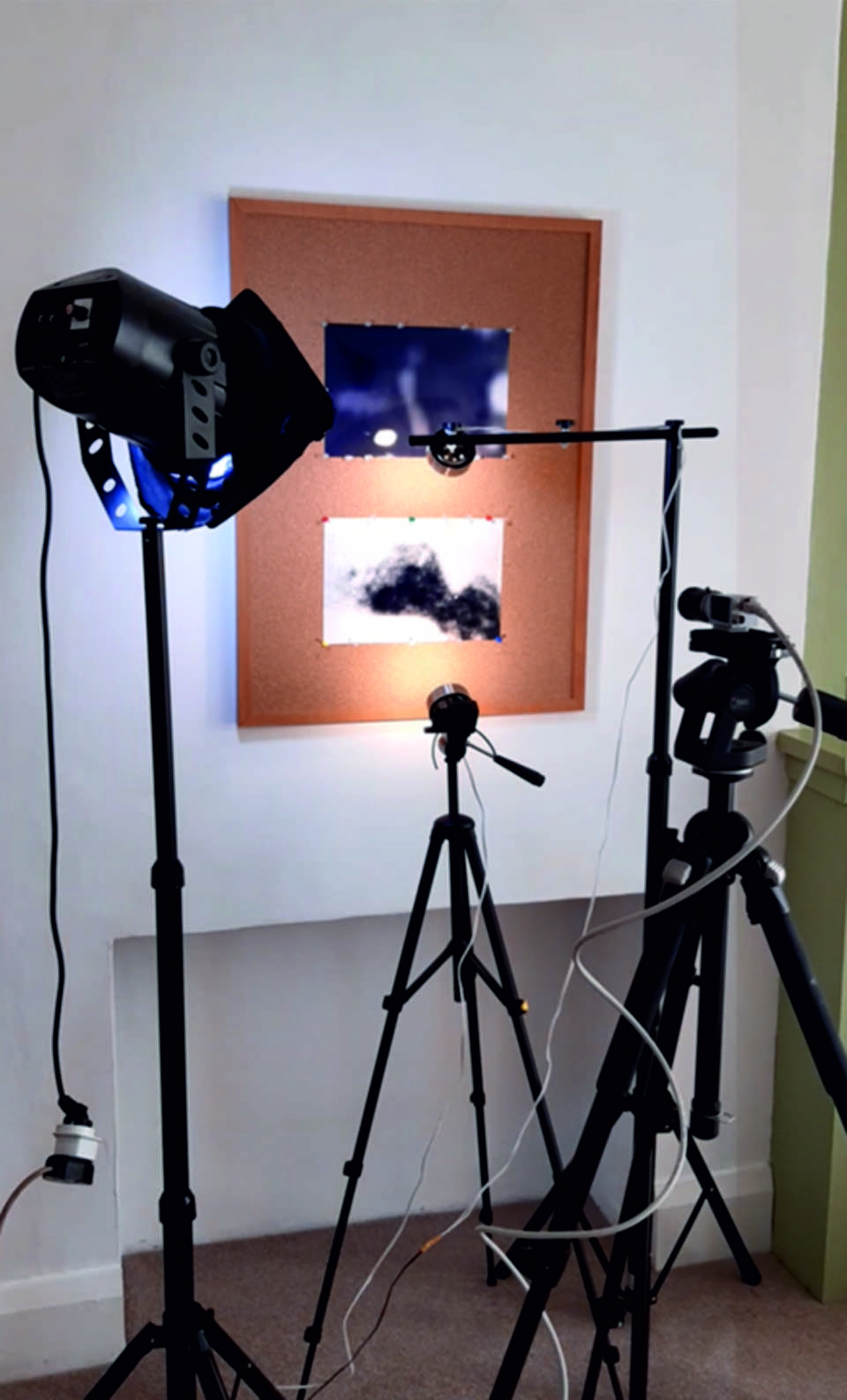
Here I would show data from plain recordings of Mary Moorman picture (no added lights) taken under a diffuse bright daylight using a slow frame rate of 10 Hz and allowing a long exposition time. These images have very little noise. Further, the recording was made using a 12-bit mono format yielding 4096 levels of grey instead of the standard 256 levels. This high dynamic range and recording images in the whole spectrum (up to about 1150 nm) allows to sample the levels of grey contained in the image with a much finer resolution of grey tones than a human eye can ever offer.
Here is an example of such recording. The top panel is the digital copy of MM picture and the lower panel is a cropped view of the printed MM picture after averaging 20 s of recording (200 images). One can see more signal at the location of the wound compared to the original digital copy and a couple more details which I could show next time.
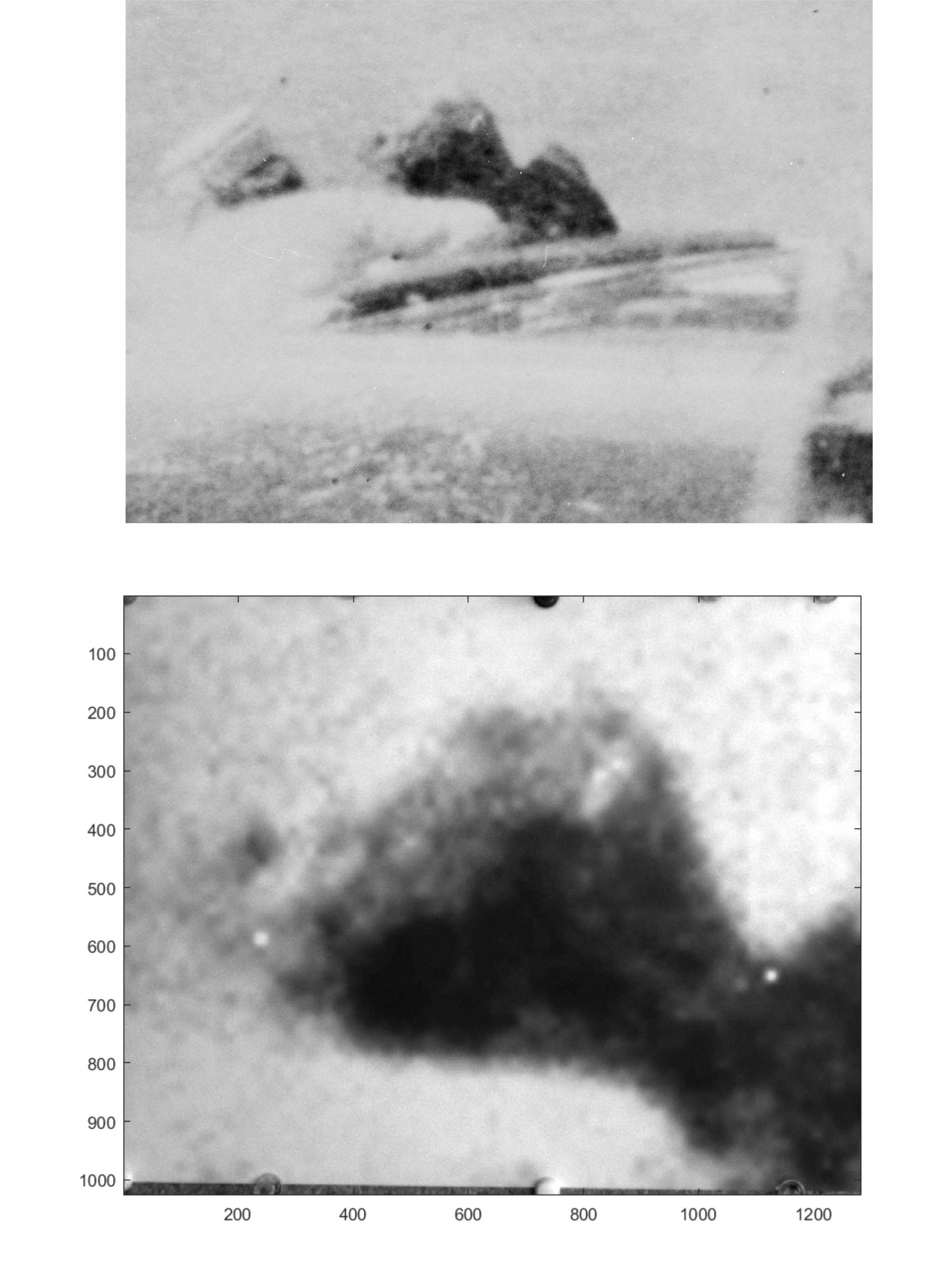
This image as it is (so, no processing at all, just averaging the video frames) was then analysed using ImageJ program. One of the remarkable features of this program is that it allows to reconstruct the gradations of grey according to the brightness gradient and shows the gradations as a 3D volume.
Here is a volume-rendered, brightness-coded (inverted), image of JFK's head in MM picture. Please note absence of any structure at a site which I delineated with red line in the lower picture. This is obviously the region where both the scalp and skull are missing. The blue line tentatively delineates the total damaged area.
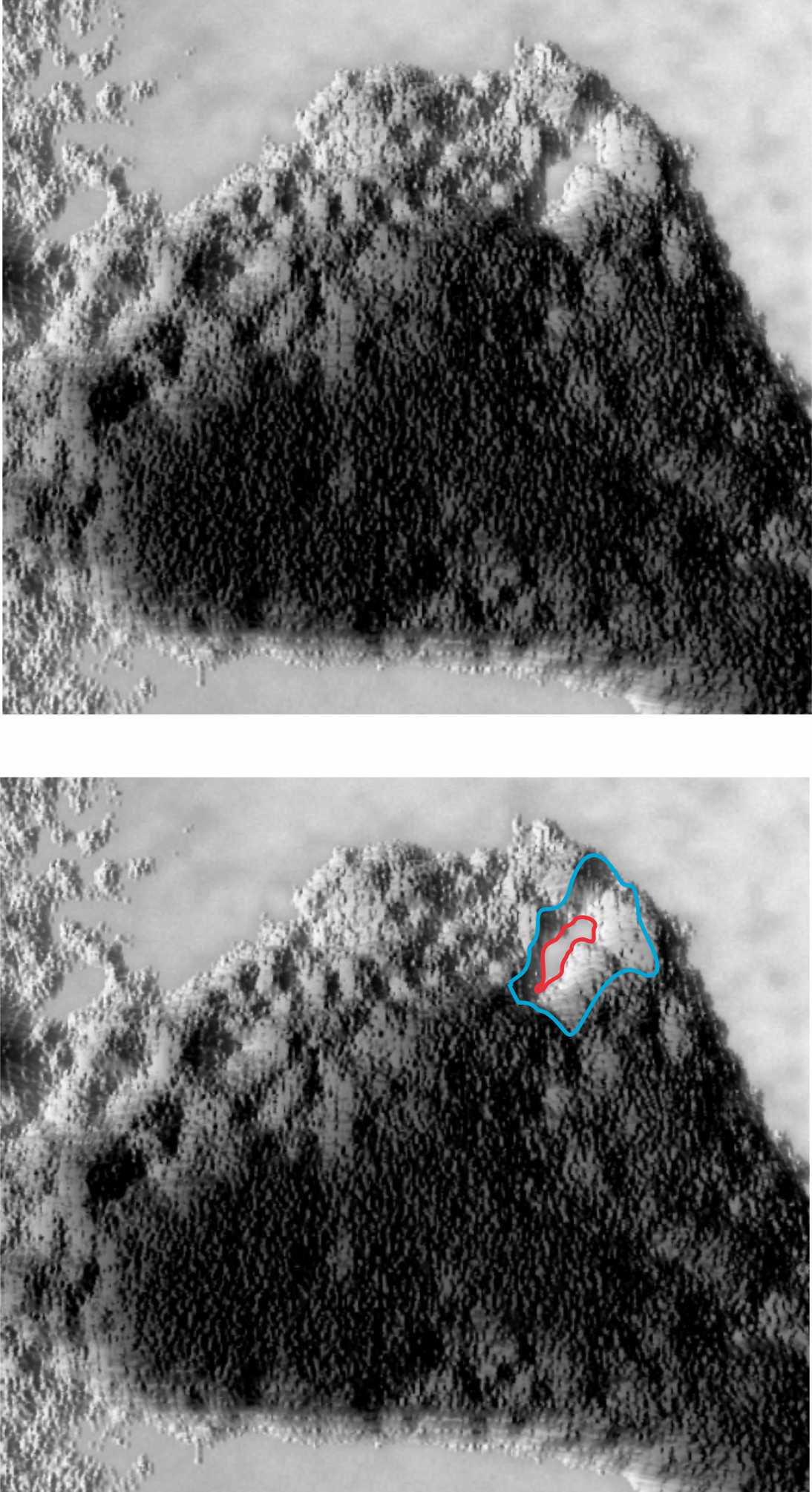
I took this volume reconstruction and placed it onto the intact head of President Kennedy to see where approximately the damage would be. The blue line shows the entire damaged area and the red line shows the deep hole spot.
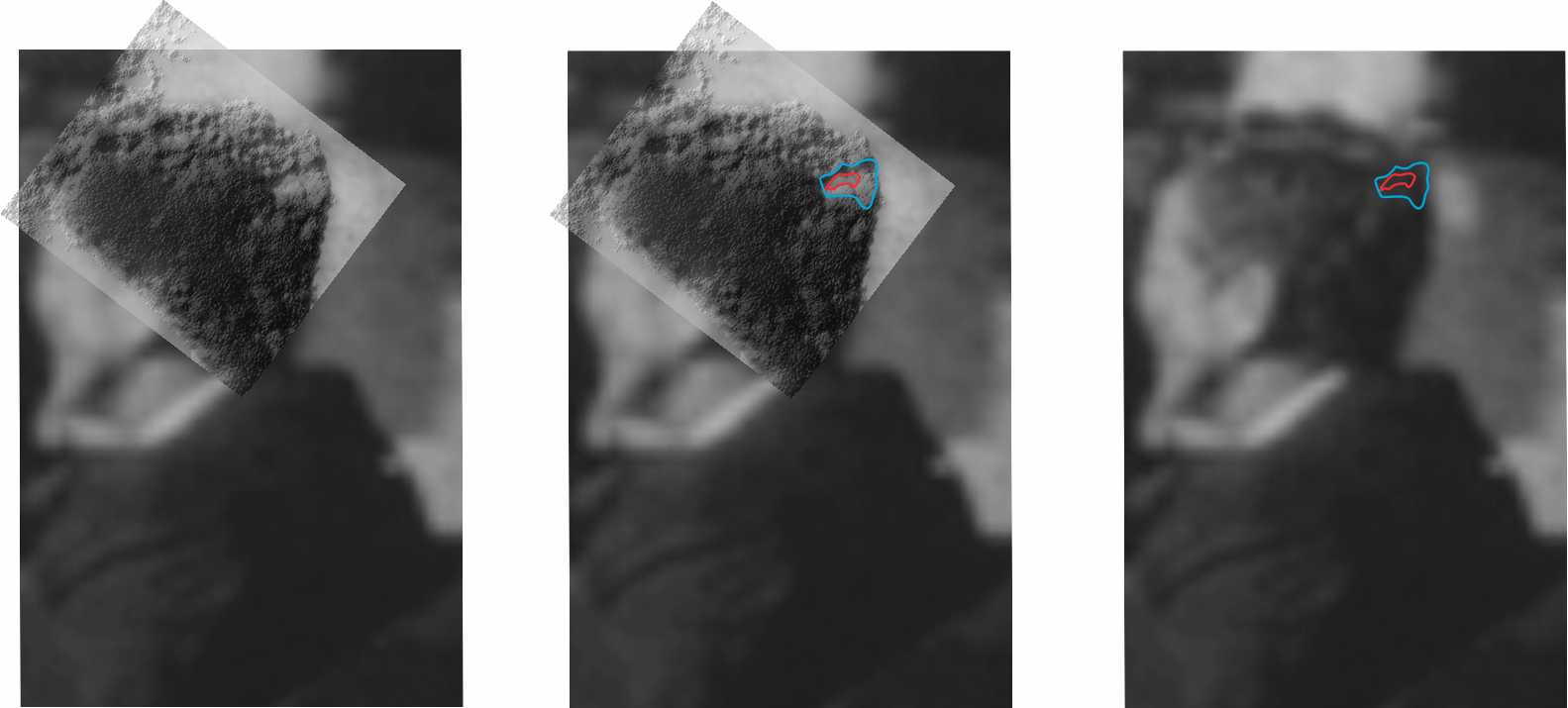
It is also possible to explore the detailed topography of the head wound. Here I prepared a coloured texture representation of the wound. In accord with Tom Wilson's data, there appear to be two tunnels expanding toward the rear suggesting exit of the missile. Whether there were two bullets (one entering in the frontal region of the head in the hairline behind and above the right eye and another in the right temporal region above and slightly in front of the right ear) or whether one bullet has split into two with each part causing one tunnel, I do not know.
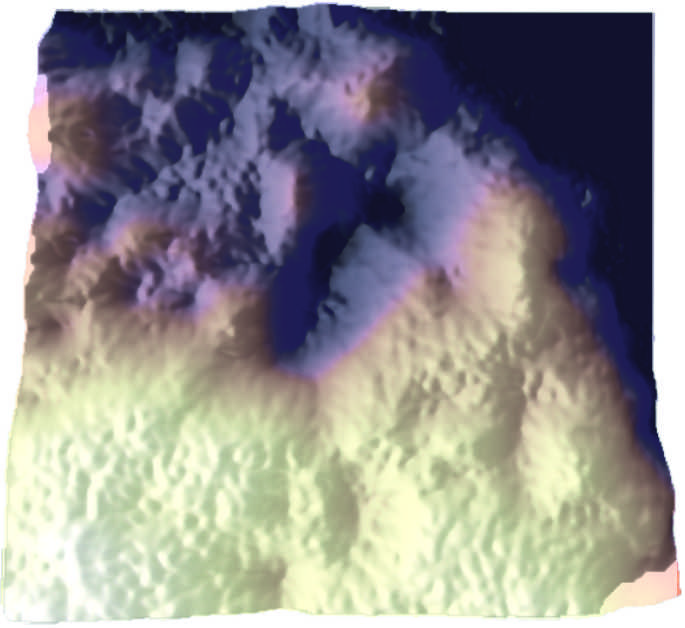
The JFKA pictures are often difficult to interpret. It may be useful to have a look on the natural structure of President's hair and copy some features onto MM picture. The picture below shows two natural paths in Kennedy's hair, traces of which can be recognised in the reconstructed MM picture. It is maybe only a detail but a useful one as it provides some orientation in what otherwise appears a non-structured mess in Mary Moorman's picture. The top pictures offers a full view of Kennedy's hair and the lower pictures contain lines corresponding to the two hair paths.
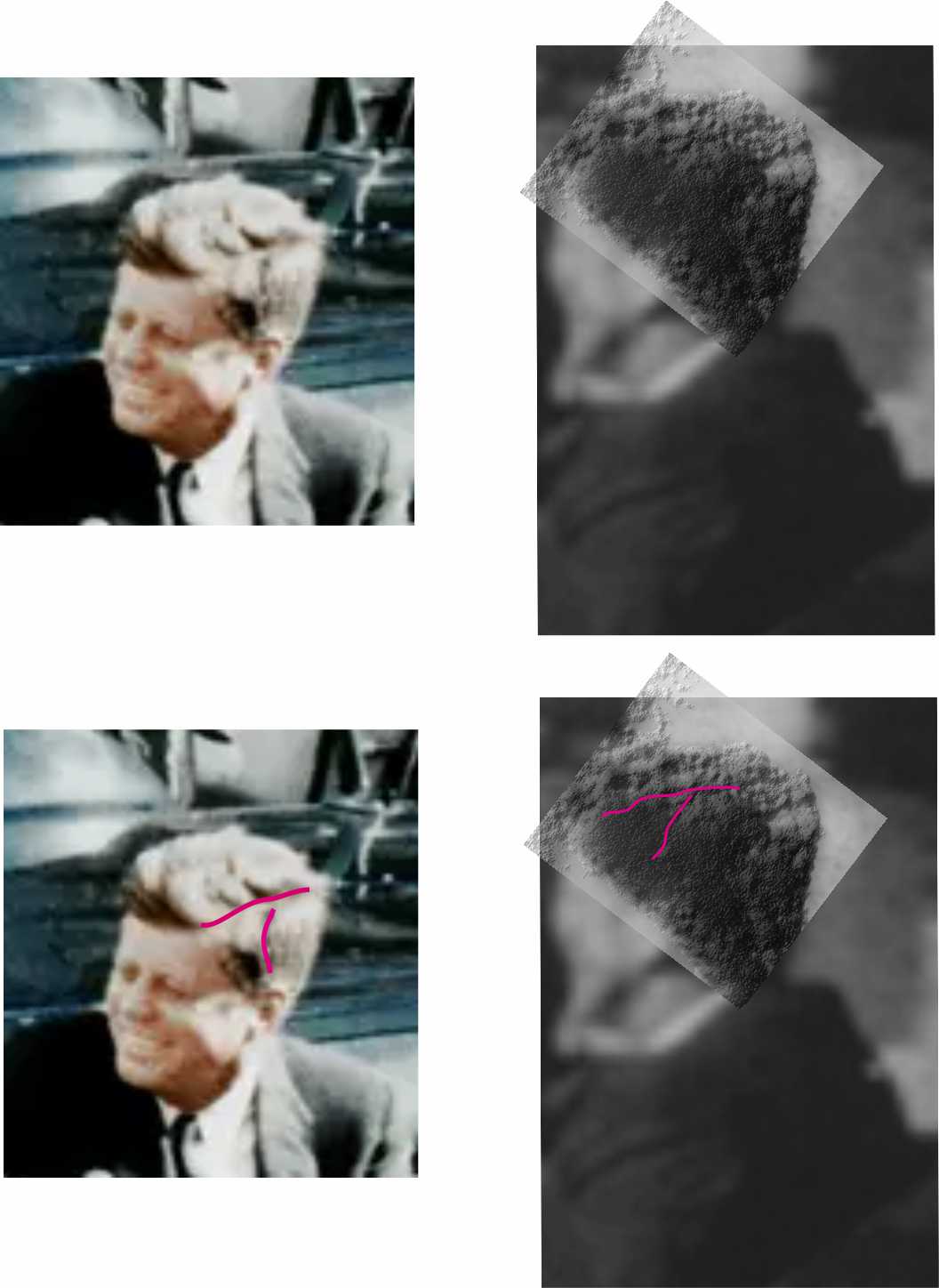
-
Thanks, Ray, for posting Tom Wilson's findings related to Mary Moorman picture. Tom was even able to prepare a 3D mold fitting the head wound based on extensive analysis of this picture.
While my work on Tom Wilson's method is still ongoing, I can share some findings which actually do not require Tom Wilson's method and yet support his work.
First, I took a high-quality picture of President Kennedy that was recorded just briefly before the shooting (however, I do not know which film or picture was it). The picture was downloaded from a web site JFK Place (Deannie Richardson) which does not exist any longer but can be still visited via waybackmachine.org. This picture is the lower of the two in the montage below. The top picture is a cropped view of JFK and First Lady in a high-quality FBI version of MM. The bottom picture shows the President from a very similar angle as the MM picture while the head is intact. Therefore, I was able to cut the head from the bottom picture and overlay it onto MM. The purpose of this small exercise was to find out what are the true contours of JFK's head in MM and what would be the tissue loss in Kennedy's head in MM picture.
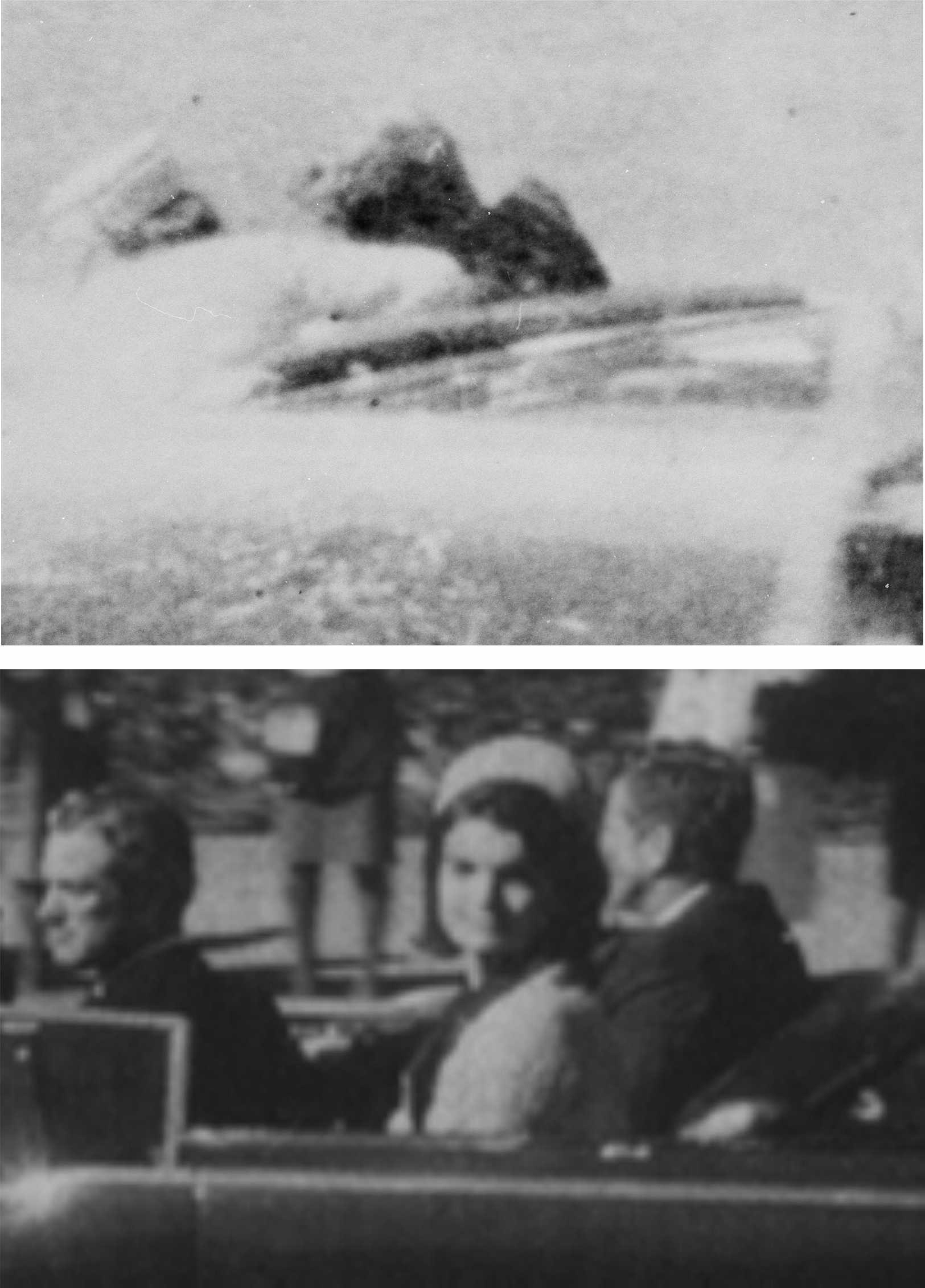
The next picture shows overlays of MM and the intact head from the picture above at different rates. 0% means that MM does not penetrate into the picture with intact head and the increasing percentages point to a stronger propagation of MM from behind the intact head. The blending of 50% and 75% are especially useful for evaluation of the size of damage to President's head.
In the context of this thread, the light-coloured flap on the right shoulder does not appear to be a part of President's body. I would not speculate at this stage about the origin of this shape.
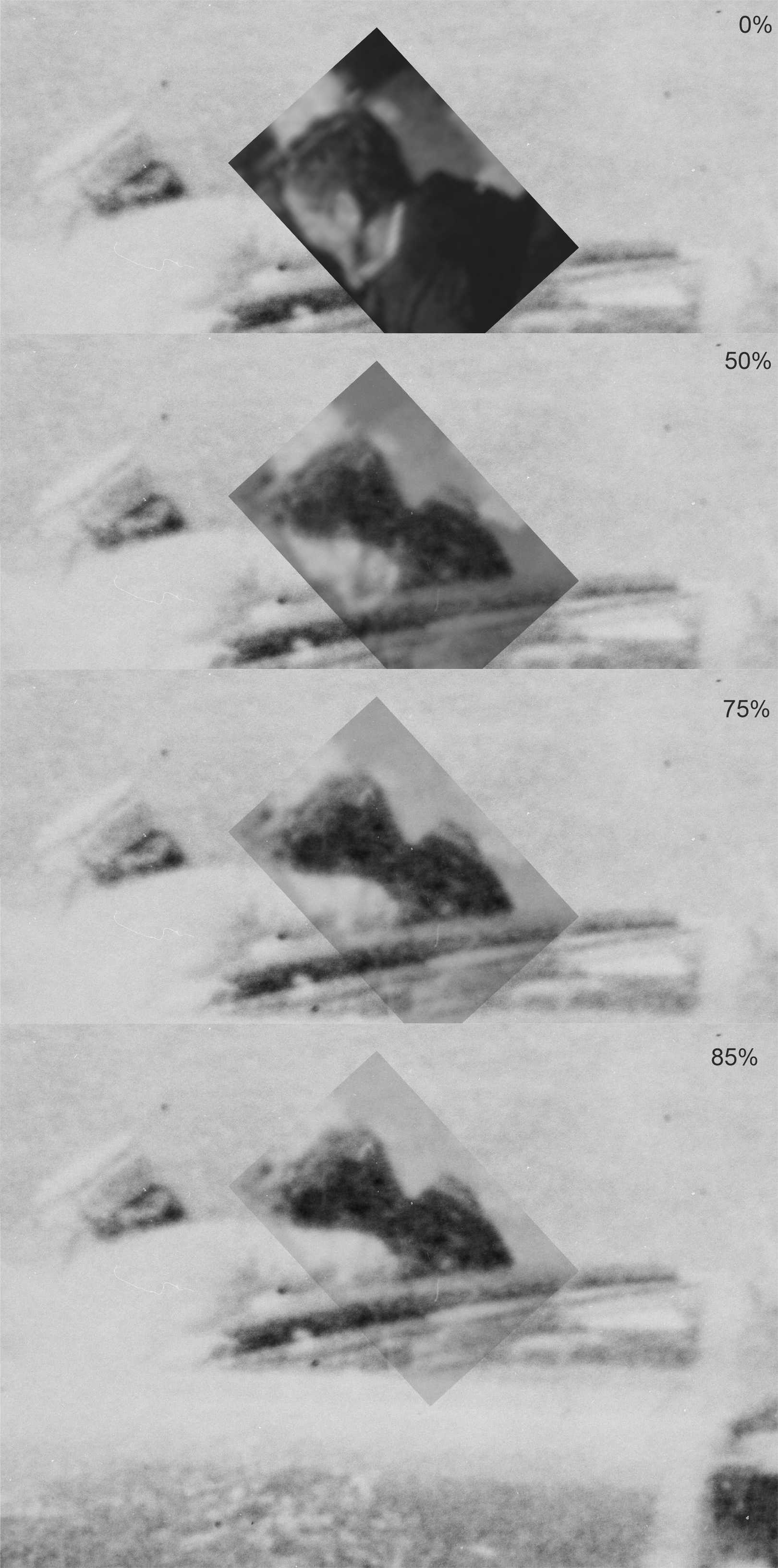
-
On 5/16/2020 at 1:45 PM, David Lifton said:
When I was studying the image, probably using a magnifying glass, the person in charge said something like: "We don't save that stuff, so if you want it you can have it. Its yours." (Really! That's what he said.) Obviously, I accepted the offer, and that's how I came to possess the San Francisco wire-service negative of the AP Wire photo designated "DN-22," a negative created (in San Francisco) when the Moorman photo was first transmitted -- nationally-- on the afternoon of November 22, 1963. The shoulder patch --which I don't believe I was aware of at the time-- was right there on the negative, but so were the various images of "the men" behind the wall, which was my main focus. These were the images that had so excited me and started me down the path of my original research -- as described in Chapter 1 of B.E.
David:
it may be too much to ask, however, many people who are seriously involved in analysis of JFK photographic materials would appreciate very much the possibility to work with a certified copy of Mary Moorman's picture. Unfortunately, this photograph circulates in too many versions on Internet and no one would dare to draw any conclusions from such copies not knowing which version is valid.
If it would be possible, could you please have your negative of Mary Moorman be scanned digitally in colour mode (even if it is a black-and-white picture) with a resolution of at least 1200 dpi and saved in a TIFF format (in no case a jpeg format). One way of granting access to the digital copy of MM picture would be to post a link to Dropbox or a similar sharing service. The file, if prepared this way, may be very large (about 100 Mb) and could hardly be emailed.
Thanks for considering my request.
-
The conversation between Bill Lynch and James Curtis Jenkins in "At the Cold Shoulder of History" may be of relevance here. Bill Lynch used to assist at the autopsies at Bethesda morgue like Jenkins, however, November 22 was not Lynch's watch. The conversation raised the issues of a head block (Bethesda morgue did not use metal plates to support the head), tiles, the location of the phone and the stretchable phone cable. However, it seems that these two gentlemen discussed a different photograph than the one showed by David. It could be the photograph showing the President from the left profile. All in all, it seems entirely possible that the initial set of pictures (before the U incision was made on the chest) was taken somewhere else.
Late edit: I just saw the picture posted by Sandy, that was the one I was thinking of.


Prayer Man is a Man
in JFK Assassination Debate
Posted
John, not at all, I believe both scenes, the Darnell and the Wiegman, are genuine. My composite picture was meant to say that if Prayer Man's head would be the alleged female face which some people claim to be Prayer Man's head, Prayer Man would be a dwarf, only reaching to the chest level on Buell Wesley Frazier's figure.